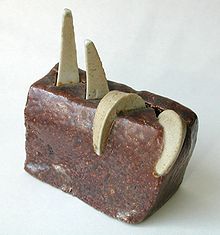Sailing cone
Seger cones (standard symbol SK ) are test bodies for determining fire resistance . They are named after the ceramicist Hermann Seger (1839–1893), who developed them in 1885 for his investigations into the fire resistance of various materials. The standard cones made of the material to be tested are about 5 cm high and slightly bevelled. The cone is slowly heated in an oven. When the tip of the cone is completely overturned and touches the ground, the cone fall temperature is determined. The Seger cone is read from the reference list:
(Abstract)
- SK 17 = 1500 ° C
- SK 27 = 1600 ° C
- SK 31 = 1700 ° C
- SK 36 = 1800 ° C
- SK 40 = 1900 ° C
There are comparison cones according to ISO , Orton or HPC. These can be converted to one another. In Germany the sailing cone was usually used until 2005 - it was no longer manufactured after that. The Orton cone is now used in many areas .
The falling point of the cone does not provide any useful information about the fire resistance of a material - it does, however, give the expert a pragmatic reference point, as it reflects the effect of temperature and time. An important use was given when burning bricks in the ring kiln, since the burning zone was circumferential. The required time was required by the circulation. The fuel supply and thus the temperature was observed by means of a Seger cone through a viewing hole in the walled-up door opening. New technologies changed the demands, for example for automatic burn control.
More reliable information is given by hot pressure resistance , resistance to temperature changes , thermal expansion and other characteristic values. The use of sailing cones is increasingly taking a back seat.
Seger cones made of a calibrated material with a defined fall point are still used to determine the temperature, preferably in kilns for ceramic and pottery. This means that the baking temperature can be sufficiently determined when ceramic products are fired. On the other hand, this use has declined since the availability of inexpensive high-temperature thermometers. In the meantime, temperature measuring rings (e.g. Buller rings) are often used instead of cones. Just like the cones and the items to be fired, they react to the effects of temperature and time in the oven. The shrinkage of the ring diameter serves as a measure of the temperature in the furnace.
